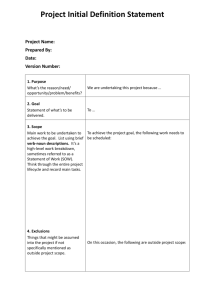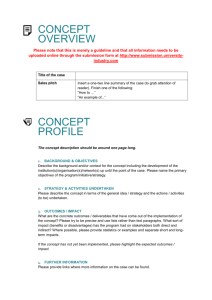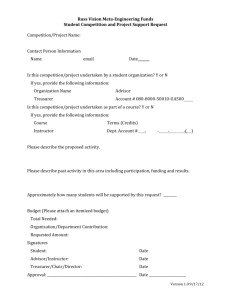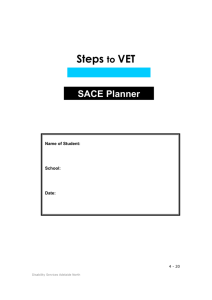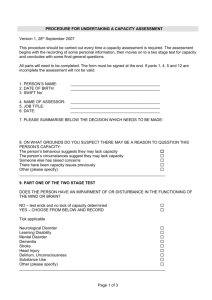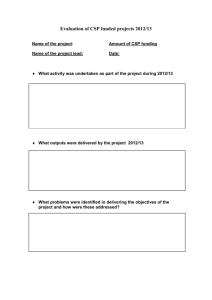Carrying out M&E activities
advertisement
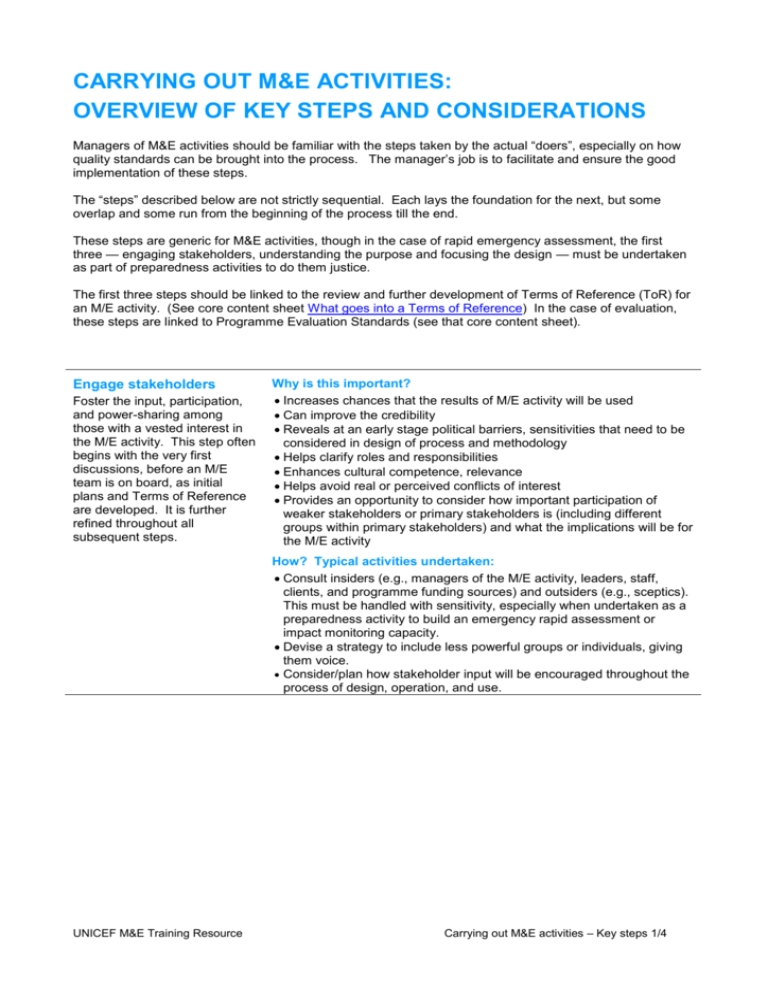
CARRYING OUT M&E ACTIVITIES: OVERVIEW OF KEY STEPS AND CONSIDERATIONS Managers of M&E activities should be familiar with the steps taken by the actual “doers”, especially on how quality standards can be brought into the process. The manager’s job is to facilitate and ensure the good implementation of these steps. The “steps” described below are not strictly sequential. Each lays the foundation for the next, but some overlap and some run from the beginning of the process till the end. These steps are generic for M&E activities, though in the case of rapid emergency assessment, the first three — engaging stakeholders, understanding the purpose and focusing the design — must be undertaken as part of preparedness activities to do them justice. The first three steps should be linked to the review and further development of Terms of Reference (ToR) for an M/E activity. (See core content sheet What goes into a Terms of Reference) In the case of evaluation, these steps are linked to Programme Evaluation Standards (see that core content sheet). Engage stakeholders Foster the input, participation, and power-sharing among those with a vested interest in the M/E activity. This step often begins with the very first discussions, before an M/E team is on board, as initial plans and Terms of Reference are developed. It is further refined throughout all subsequent steps. Why is this important? Increases chances that the results of M/E activity will be used Can improve the credibility Reveals at an early stage political barriers, sensitivities that need to be considered in design of process and methodology Helps clarify roles and responsibilities Enhances cultural competence, relevance Helps avoid real or perceived conflicts of interest Provides an opportunity to consider how important participation of weaker stakeholders or primary stakeholders is (including different groups within primary stakeholders) and what the implications will be for the M/E activity How? Typical activities undertaken: Consult insiders (e.g., managers of the M/E activity, leaders, staff, clients, and programme funding sources) and outsiders (e.g., sceptics). This must be handled with sensitivity, especially when undertaken as a preparedness activity to build an emergency rapid assessment or impact monitoring capacity. Devise a strategy to include less powerful groups or individuals, giving them voice. Consider/plan how stakeholder input will be encouraged throughout the process of design, operation, and use. UNICEF M&E Training Resource Carrying out M&E activities – Key steps 1/4 Define/understand the purpose Clearly defining the expected users and end use of the M/E activity and what is to be monitored and evaluated shapes the design of the M&E activity. Managers of M/E activities can lay the purpose out in a ToR and use that to hire an M/E expert, but the ToR then needs to be revisited and is often refined. In evaluation, this will involve a preliminary description of the programme to be evaluated to ensure a clear understanding of its purpose, placing this accurately in the wider context. Focus the design Move from the broad purpose to a logical description of what will be done and how. The process is iterative (i.e., it continues until a focused approach is found to answer questions with methods that stakeholders agree will be useful, feasible, ethical, and accurate). Questions and methods might be adjusted to achieve an optimal match that facilitates use by primary users. Again, an initial ToR may outline some of this, but those carrying out an M/E activity will be involved in reviewing and likely refining the design. UNICEF M&E Training Resource Why is this important? Increases chances that the results of M/E activity will be used, including defining users’ preferences/needs in terms of methods used Provides important reference for scope of M&E activity and prioritisation of questions to be answered Focuses on timing of results of M&E activity, focusing actual work plan How? Typical activities undertaken: Conduct preliminary investigation, review existing information in secondary sources. Meet with stakeholders to clarify the intent or purpose of the M/E activity. Identify key users in consultation with managers of M/E activity. Draft initial broad-level questions to be answered. For programme evaluation, characterise the programme to be evaluated through documentary review and consultation with key stakeholders, including defining: the need/problem it addresses; the goals, expected outcomes and criteria for success; why and how program activities are believed to lead to expected changes; the programme logic model (expected sequence of inputs, activities and subsequent chain of results and corresponding assumptions); the programme’s stage of development; and the prevailing context, including links to other ongoing efforts. For rapid assessment or impact monitoring in emergencies, this will be focused by agency mandate and issues of concern as well as by likely scenarios in which data collection will take place, i.e. type of natural disaster or scenario in complex emergency. Why is this important? Increases chances that the results of M/E activity will be used Further refines scope of M/E activity and prioritisation of questions to be answered Ensures design is structured to respond to questions as completely and accurately as possible (especially validity of measures, i.e. do stakeholders agree that proposed indicators are acceptable measures) In the case of performance M/E, ensures design responds to questions as fairly as possible Ensures stakeholders consider M/E activity to be practically feasible and cost-effective; helps establish commitment of stakeholder resources Provides opportunity to consider protection of participants in M/E activity – e.g. interviewees, sources and others stakeholders particularly at community level. Establishes limitations of design, perspectives of M/E experts and impartial reporting How? Typical activities undertaken: Further define questions to be answered — those that can be answered using existing documentation and those requiring new data collection Prepare an initial outline of practical methods for sampling, data collection, data analysis, interpretation, and judgement (including provisions for protection of human subjects) and present this for review by key stakeholders, reference groups or other quality control mechanisms Prepare a written agreement with manager/key stakeholders that summarises the work plan for activities associated with data collection, analysis and use/sharing activity procedures, noting any specific procedures as well as clear roles and responsibilities for all stakeholders Prepare and pre-test draft data collection instruments. Revise plan as necessary Revise all or part of the plan when critical circumstances change Prepare a draft outline of the final report or related products Carrying out M&E activities – Key steps 2/4 Collecting evidence Compile information that stakeholders perceive as trustworthy and relevant for answering their questions. Adequate data might be available and easily accessed, or new data might need to be collected. Credibility depends on factors such as how the questions were posed, sources of information, conditions of data collection, reliability of measurement, validity of interpretations, and quality control procedures. Analysis, conclusions and recommendations Process and test data gathered according to accepted procedures; draw conclusions that follow logically from this and are consistent with the agreed values or standards of stakeholders; make logical and coherent recommendations. UNICEF M&E Training Resource Why is this important? Increases credibility Ensures accuracy, including the reliability of measures, i.e. that instruments are applied as consistently as possible For performance M&E, ensures fairness Ensures protection of human subjects, at least as defined in design How? Typical activities undertaken: Prepare for field site visits contacting key stakeholders at local levels (authorities, partners, etc.), clarifying expectations Document fully the information sources used, an analysis of their limitations and the rationale for their selection Establish clear procedures to collect high-quality information (what instruments are used, how, when) and recruit and train data collection assistants and translators accordingly. In the case of rapid assessment and impact monitoring in emergencies, this is ideally undertaken as part of preparedness activities. Estimate in advance the amount of information required or establish criteria for deciding when to stop collecting data in situations where an iterative or evolving process is used Collect data Monitor data collection and take practical steps to improve quality Monitor practice of procedures to protect participants in M/E activity – e.g. interviewees, sources. Monitor security of data collection assistants where appropriate Why is this important? Ensures conclusions are as accurate as possible, and in the case of performance M/E, as fair as possible Increases political feasibility of recommendations Increases chances that the results of M/E activity will be used How? Typical activities undertaken: Summarise findings using acceptable methods of analysis and synthesis Weigh the significance of results for deciding what the findings mean Classify results (e.g. as positive or negative, high or low, degrees of priority for response) according to clearly defined standards. This is critical for M/E in crisis and unstable contexts. Consider alternative ways to compare results (e.g. a comparison group, national norms, primary stakeholders’ perceived needs, and/or in the case of programme evaluation, past performance or stated programme objectives) Generate alternative explanations for findings and indicate why these explanations should or should not be discounted Meet with the team and then managers to evaluate the M/E activity itself Document limitations of conclusions in terms of cases, time periods, contexts and purposes for which the findings are applicable Share, review and validate findings and conclusions with key stakeholders if possible Draft recommendations and lessons learned as consistent with conclusions, ideally with involvement of key stakeholders (internal and external) Share and discuss recommendations and lessons with stakeholders Note, in rapid assessments in crisis and unstable contexts, data analysis will often take place to a large extent in the field as data collection progresses. Carrying out M&E activities – Key steps 3/4 Sharing and using M&E results Why is this important? Try to increase the chances that key stakeholders are aware of results of the M/E activity – its conclusions, recommendations and lessons where applicable – that those stakeholders consider those results in decisions or actions they take, and that those involved in the process have benefited in some way. This is the desired outcome of all M/E activities. How? Typical activities undertaken: Review design to ensure it will help achieve intended use by intended users Provide continuous feedback to stakeholders regarding interim findings, provisional interpretations, and decisions to be made that might affect likelihood of use Prepare stakeholders for eventual use by rehearsing possible decisions and actions based on different M/E results (ask “what would be your response if the M/E activity tells you ‘x’?”). Prepare a draft report; revise and finalise report based on comments; prepare other dissemination formats targeting different audiences as agreed with M/E managers: summaries, presentations, bulletins, etc. Send copies of report(s) to interested parties as agreed with M/E managers Organise/participate in debriefing sessions with stakeholders (depending on how involved they have been in previous step) Meet with programme managers and others to discuss implementation and follow-up Facilitate follow-up presentation and dissemination of results to different audiences as opportunities arise Table adapted from: CRC (1999) Framework for program evaluation in public health. MMWR 1999; 48 (No. RR-11) UNICEF M&E Training Resource Carrying out M&E activities – Key steps 4/4
